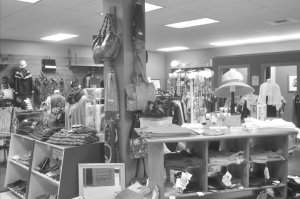“The recurring word was ‘uniform,’ as in ‘creating my uniform for the season,’ ” he recalled. “It was a word that had been going off in my mind, because that’s what I do — I create uniforms for myself every season. And I thought, what can I do with this?”
A few years later, Lewk (pronounced “look”) was born. Kuhlman, in partnership with marketing pro Drew Pearson, quietly launched the Minneapolis-based start-up at the end of December. Its aim: to set up style-conscious men with a “uniform” of wardrobe staples, one month at a time, via subscription.
Kuhlman is one of the most recognizable names in Minnesota retail, best known for his namesake store, which specialized in fashion-forward men’s shirts featuring his own designs. At its peak, Kuhlman boasted 60 locations throughout the U.S., including four in the Twin Cities area, before shuttering in 2008.
“I could see that [the traditional retail model] wasn’t working,” Kuhlman said. He doesn’t see e-commerce as the solution, either. “I’m not going to look through 36 pages of shirts to find a shirt that I want, so even I think that’s broken,” he said.
With Lewk, Kuhlman and Pearson have spent two years building what they believe to be the answer. The slang term “lewk” refers to someone’s signature style. “We looked it up on Urban Dictionary,” said Pearson, “which defined it as a guy who has an overall curated look — from a one to 10, he’s a 12.”
“We wanted something that was simple, memorable and portrayed confidence,” Pearson said of the company’s name. “And it just so happened that [lewk.com] was actually for sale. Finding a four-letter URL is incredibly difficult, so we did a happy dance and high-fives.”

A would-be subscriber begins on the website by selecting one of three plans, ranging from $79 for two items per month to $399 for four. From there, he fills out a quick interactive profile, in which he answers lifestyle questions and enters his sizes, before creating an account. (If he likes to rock chinos with gingham shirts, he’s “classic.” If he swears by his Red Wing boots and selvage denim, he’s “heritage.”) Subscribers also may opt in for on-demand packages, such as a head-to-toe look or a trio of selvage twill pants.
“We know that guys hate to shop but they want to look good,” Kuhlman said. “Our mission is to make that convenient.”
The catch? You can’t return the clothes for a refund if you don’t like them — they’re yours to keep. While this may turn off some potential subscribers, Kuhlman isn’t concerned. “You only have to be right 50 percent of the time,” he said. “If we send two items and one of them is spot-on, they’re good with that. Plus, you would have paid much more for that one item anyway.”
For instance, Lewk’s first $79 box, which goes out to subscribers at the end of January, will contain a pair of Japanese selvage denim jeans and a white oxford shirt — a seriously good deal considering that most high-end selvage jeans retail for $200 to $350.
Designed in Minnesota
Lewk isn’t the first clothing subscription service on the block. There are at least five other menswear services, including Trunk Club and Five Four Club, and too many women’s subscription services to count.
But unlike its competitors, Lewk’s goods are designed in-house by Kuhlman himself, rather than purchased wholesale, which allows the company to pass on the savings to the customer. (He said most of Lewk’s clothing is manufactured in small factories in Turkey, Italy and China.)
Although he declined to reveal early numbers, Kuhlman said the subscription model affords Lewk the predictability of recurring revenue, reducing risk.
“Retail’s pricing structure is based on speculation,” he said. “It’s what retailers call out-the-door pricing. It means retailing something for $200 but selling the bulk of it at 50 percent off, so $100 is where the costing has to be. I always thought for the consumer, that’s a losing proposition. Where with this model, you’re getting a much better value.”
He put it another way: “There’s a saying that classic retail is a one-night stand, where a subscription is a long-term relationship.”



